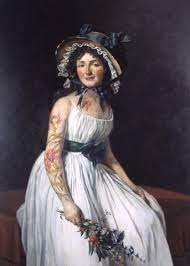Kathleen Gilje
Photograph Source
From ARTFORUM
Kathleen Gilje's line of inquiry is anything but unfamiliar. The unmasking of the male gaze has been a mainstay of critical theory and contemporary art since before Cindy Sherman staged her first photograph. But Gilje's complex, often surprising project questions the terms of the feminist reading previously advanced by her colleagues: A degree of considered complicity with the object of her critique is undeniable.
Gilje, a New York-based artist, trained as a restorer of fine art and has worked with master paintings from private and museum collections. Her recent show included portraits of women based on paintings by Rogier van der Weyden, Georges de La Tour, and others. Each figure is clothed in her original costume but now exposes her breasts; one pinches her own nipples, another displays a fresh tattoo spelling out “LOVE,” a thin trickle of blood dripping down her arm. The young onlooker in La Tour's 1630s Fortune Teller (part of the Metropolitan Museum's collection) has been completely divested of her dress and holds a glass of wine instead of the watch La Tour shows her stealing. Removed from the scene in which she is usually encountered, the nude figure looks more awkward than furtive, making the viewer feel similarly self-conscious.
The three main works in the show continue in this vein while adopting a more didactic tone through the use of extensive wall labels, mimicking the authoritative voice of the museum. In her version of Rembrandt's Danaë, 1636–47, Gilje substitutes the cloud of gold in which Jupiter disguised himself with a silvery blue sheet of splashing liquid. This substance, we learn from reading the deadpan wall text, signifies the acid thrown at Rembrandt's painting in 1985 by a deranged man at the Hermitage, which ended up erasing the figure of Danaë. Such an act of violence puts the work in the hands of the restorer, whose job it is to rescue the body of the king's daughter. Artist, criminal, and conservator do not have entirely distinct roles: Each expresses a certain passion for the body in question, and each engineers or modifies its representation. Similarly, in Gilje's reproduction of Rubens's 1630s Het Pelsken, she adds two dark, hairy hands that emerge from beneath the fur coat worn by the model, Rubens's pale young wife, Helena Fourment; the long, muscular fingers press into Helena's ample flesh, probing the surface of her form just as Rubens (like Gilje, and like Danaë's attacker) manipulates the subject and the surface of the canvas.
Gilje acknowledges her own involvement in the process by attaching the word “restored” to her titles. The other large piece on view was Woman with a Parrot, Restored, 2001, painted after Courbet's 1866 original. This was the most layered work, in that Gilje's alteration is based on speculation by historians that the relatively empty right half of the canvas might at some point have held another figure. Gilje painted a version that included the naked form of Courbet himself, a comment on his narcissistic interest in self-portraiture.
She then painted him out to match the original. Finally, using a process common to art restoration, she took an X-ray of her first version, revealing her “discovery.” Gilje thus restores the work to its ostensibly rightful place in a discourse of desire.

